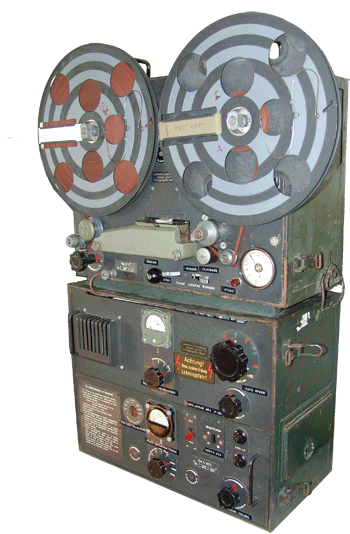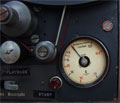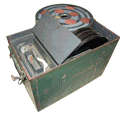|
|





This is the oldest recorder in t
This is the oldest recorder in the Vintage Recorders collection, this
recorder stands as a mile stone upon other recorders, these where the machines
captured by the British and Americans in the Second World War and thanks to
these machines, the development into other machines such as Ampex and EMI began.
These machines are very hard to come by, I was fortunate enough to have a friend
who had contacts in the sales of military equipment from the first and second
world wars, fortunately for me the recorder also came with the reels and a box
of spares, it would be very unlikely that I would get another as most of these
machines are now on display in museums.
The recorder has the usual basic functions found on any machine, record,
playback and rewind, unusual about this machine, the large clock to the left of
the tape recorder, this in fact is a tachometer for the capstan as it was hard
to keep these machine running at a constant speed hence the fine tuning speed
controller. When operating the recorder in play or record, the start-up time was
very slow so there is a start button as well as the play function, the start
gives the capstan motor an initial boost to get it up to speed, then after a
little while the capstan will settle down to the correct running speed. The
capstan is driven from two valves, these valves act as the timing frequency to
drive the motor, giving a frequency of 20 to 195Hz to the motor, as the valves
warm up over time, the speed drifts hence the tachometer to keep an eye on this
and make appropriate adjustments if needed.
The recorder has a audio indication tube or valve called the “Glimmtube”, the
louder the music, Mores or speech, the more the tube glows but there is no level
indication to where the saturation or clipping may take place. This recorder is
also thought to be before AC biasing, AEG brought this out in 1941 but it is
quite possible that the 1939-1944 models didn’t have this for military use as
most of the time the recorders were recording speech or Mores code.
A very unusual feature of the recorder is a rotary head, there is a set of four
heads inside the left hand roller directly above the “Tonhöhe” control (Tone),
this unusual device was used to change the pitch of the playback but not the
speed which the tape moved over the heads, the idea was for translating high
speed mores code, you would record the mores at 72cm/sec, then play it back at
36cm/sec, according to the paperwork, the mores signal be no longer be audible
at these speeds. By engaging the Tonhöhe control, the heads would spin depending
on how fast the operator wanted the effect of passing the heads or scanning the
heads over the tape causes the replay frequency to be higher whilst the tape
speed can then be reduced.
On the amplifier stage itself, there are two indication meters to measure the
emission of the valves, this gives the operator a fast valve tested built into
the recorder making fault diagnostics very fast, usually a set of spare valves
are kept in the third box for when this fault should occur.
|
Specifications |
|
|
Era |
1939 - 1944 |
|
Customer |
Military |
|
Cost when sold |
Unknown |
|
Control type |
Half mechanic with solenoid control |
|
Max Spool size |
11" reels |
|
Speeds |
3.5", 5.1", 7.1", 7.5", 9.8", 14.2", 20.5", 28.3",
40.9", 47.2" |
|
Motors |
Three, Capstan, reel motor and rotary head motor |
|
Heads |
7, erase, record playback and 4 in a rotary head |
|
Track configuration |
Mono full track |
|
Speed variation |
Variable to attempt to lower Wow and flutter |
|
Wow and flutter |
Very high, unknown |
|
Frequency response |
50Hz to 5KHz @ 120 c./second |
|
Signal to noise ratio |
Unknown |
|
Distortion |
Unknown |
|
Connections |
500 ohm mic, line input via a transformer |
|
Size of case A |
470 X 490 X 715mm |
|
Size of case B |
470 X 490 X 715mm |
|
Weight of box A |
32Kg |
|
Weight of box B |
32Kg |
|
Power supply |
110V,125V, 145V, 165V, 190V, 220V,250V @ 25Hz to 60Hz |
|
Tape controls |
Replay, record and rewind |
|
Valves used |
7 X RV12P2000, 2 X LS50, 1 X Glimmtube UR110 |
|
Special features |
Rotary head for pitch bend, variable speed control,
capstan tacho, built in valve testers. |
Click SSB button to see Spec Sheet
Backdrop

|



